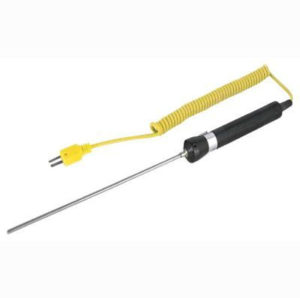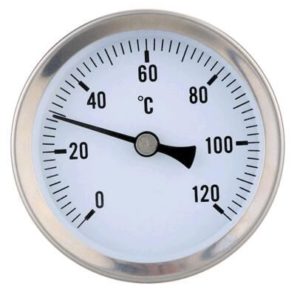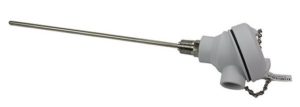TEMPERATURE
Temperature measurement, also known as thermometry, describes the process of measuring a current local temperature for immediate or later evaluation. Many methods have been developed for measuring temperature. Most of these rely on measuring some physical property of a working material that varies with temperature.
One of the most common devices for measuring temperature is the glass thermometer. This consists of a glass tube filled with mercury or some other liquid, which acts as the working fluid. Temperature increase causes the fluid to expand, so the temperature can be determined by measuring the volume of the fluid. Such thermometers are usually calibrated so that one can read the temperature simply by observing the level of the fluid in the thermometer.
Other important devices used for temperature measurement: 1) Thermocouples, 2) Thermistors, 3) Resistance temperature detector (RTD), 4) Pyrometer.
A Thermocouple is a sensor used to measure temperature. Thermocouples consist of two wire legs made from different metals. The wires legs are welded together at one end, creating a junction. This junction is where the temperature is measured. When the junction experiences a change in temperature, a voltage is created. The voltage can then be interpreted using thermocouple Std. reference tables to calculate the temperature.
There are many types of thermocouples, each with its own unique characteristics in terms of temperature range, durability, vibration resistance, chemical resistance, and application compatibility. Type J, K, T, & E are “Base Metal” thermocouples, the most common types of thermocouples. Type R, S, and B thermocouples are “Noble Metal” thermocouples, which are used in high temperature applications
A thermistor is a resistance thermometer, or a resistor whose resistance is dependent on temperature. The term is a combination of “thermal” and “resistor”. It is made of metallic oxides, pressed into a bead, disk, or cylindrical shape and then encapsulated with an impermeable material such as epoxy or glass. There are two types of thermistors: Negative Temperature Coefficient (NTC) and Positive Temperature Coefficient (PTC). With an NTC thermistor, when the temperature increases, resistance decreases. Conversely, when temperature decreases, resistance increases. This type of thermistor is used the most. A PTC thermistor works a little differently. When temperature increases, the resistance increases, and when temperature decreases, resistance decreases. This type of thermistor is generally used as a fuse.
Resistance Temperature Detectors, or RTD’s, are sensors used to measure temperature by changing resistance proportional to the temperature. RTD’s are designed with basic temperature elements as well as fully packaged assemblies. Various sensor materials are available based on customer requirements for material compatibility, accuracy, and measurement range.
In many production and process industry, the material temperature as well as the control of material temperature plays an important role. Depending on the type of material and medium used, different thermometers or temperature sensors can be used. Simplisol Technologies offers the industry, a wide range of temperature measuring devices, temperature switches, temperature transmitters and temperature sensors, which can be permanently installed or can be used as hand tools.




